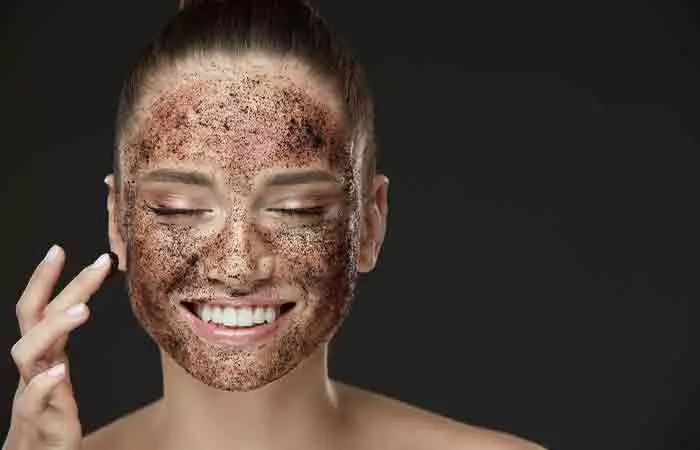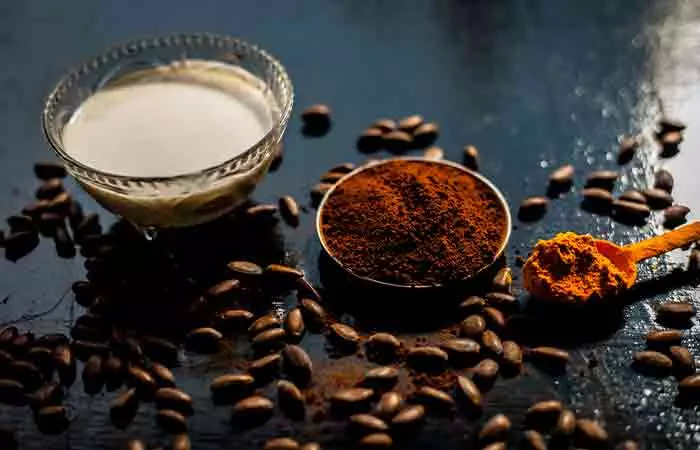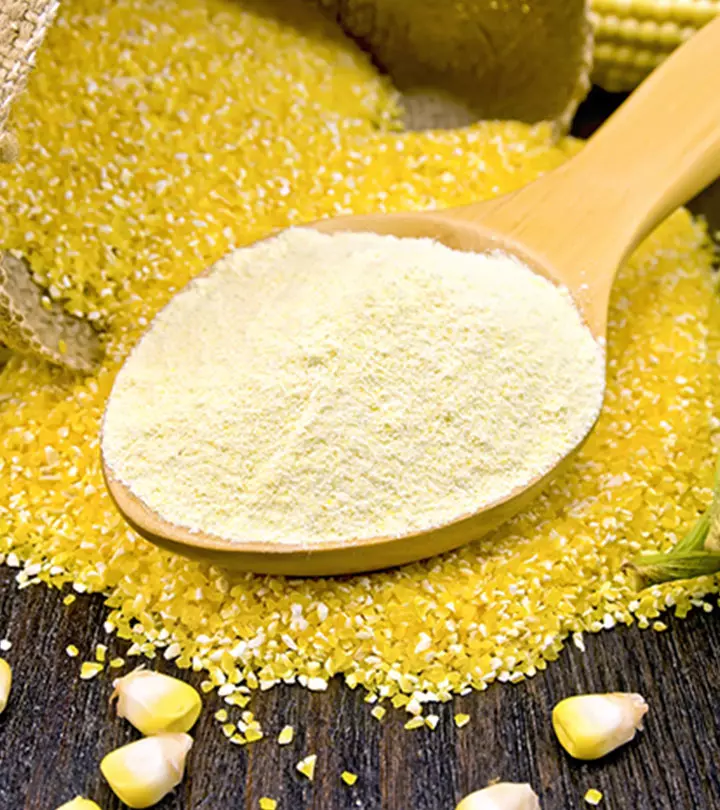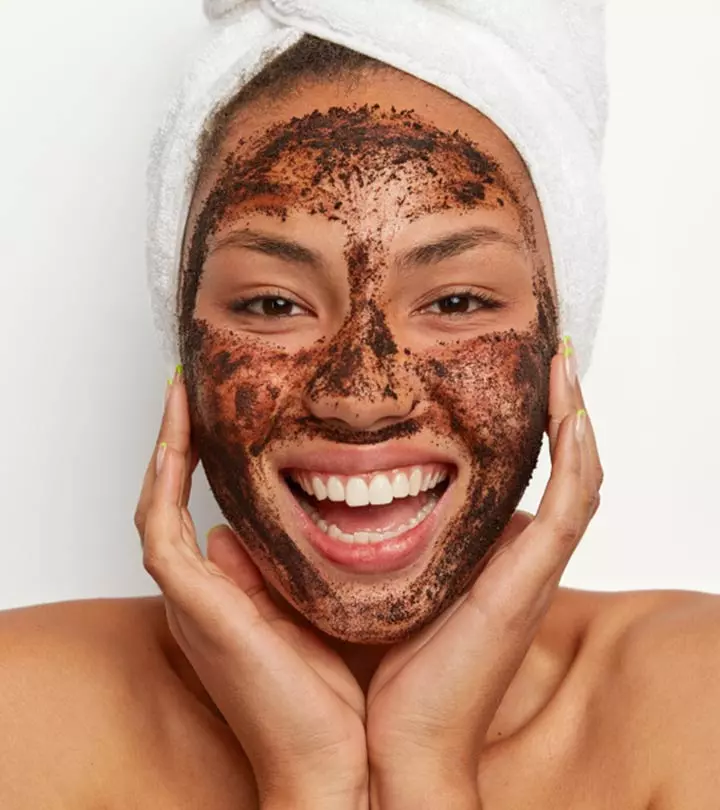9 Impressive DIY Coffee Face Masks And Their Benefits
Brew yourself a cuppa and make a luxurious mask to brighten your day and face.

Image: Shutterstock
Nothing wakes your senses up as the earthy smell of freshly brewed coffee. Besides kickstarting your day, coffee can also rejuvenate your skin. A DIY coffee mask is the best way to hit the refresh button on your skin.
Coffee contains caffeine, an ingredient that gained attention for its anti-aging and photoprotective benefits. Moreover, coffee face masks are easy to prepare, smell heavenly, and do not contain chemicals like commercial face masks. They can improve skin texture and keep it soft. Scroll down to check the benefits of coffee face packs and learn DIY recipes.
In This Article
Benefits Of Coffee Face Masks
If you want to experience the best natural skincare, a homemade face mask gives amazing results with the luxuriousness of an at-home spa. And coffee is the ultimate skin care ingredient for your face! Keep reading to know why.
1. Exfoliate The Skin


Exfoliate your skin with a good coffee scrub. The coffee granules have a coarse texture. When massaged onto the skin, they can help exfoliate it, remove dead skin cells, and eliminate dirt and sebum from the pores to keep it clean and improve its texture. A DIY coffee scrub is an excellent way to achieve this, as you can customize the ingredients to suit your skin’s needs and enjoy the fresh, invigorating scent of coffee.
2. Prevent Fat Accumulation
Coffee contains caffeine, which is a common ingredient in anti-cellulite cosmetic products. It helps prevent fat accumulation in your skin cells (1). If you are trying to lose facial fat, other than doing facial exercises and following a cardio routine, you can also use coffee face masks.
3. Prevent UV Damage

Caffeine has antioxidant properties that protect the skin from UV radiation and prevent the signs of photoaging, like dark spots, fine lines, wrinkles, and hyperpigmentation. Usually, commercially available skin care products contain 3% caffeine (1).
4. Prevent Free Radical Damage
Coffee contains caffeic acid, which is a natural phenolic antioxidanti An antioxidant that prevents the destructive effects of free radicals by neutralizing them and reducing oxidative stress. . Caffeic acid prevents the damage caused by harmful free radicals and reduces oxidative stress, one of the main causes of premature aging (2). Thus, using a coffee face mask can keep your skin youthful.
The caffeine content in coffee makes it a great ingredient for your skin. Scroll down and check out some easy DIY coffee face mask recipes for your skin.
Key Takeaways
- Homemade coffee face masks are easy to prepare and have anti-aging and photoprotectivei The property of a substance to offer protection from damage caused by excess sunlight, like aging and physical stress. properties.
- They are chemical-free and help improve skin texture, prevent free radical damage, and exfoliate the skin.
- You can prepare effective DIY coffee face masks by combining coffee with ingredients like honey, milk, turmeric.
DIY Coffee Face Mask Recipes
Ready to give your skin a little TLC? DIY coffee face masks are great home remedies to rejuvenate the skin. Each recipe blends coffee with other natural ingredients, such as honey, milk, turmeric, yogurt, etc., to deliver targeted benefits for your skin. So, scroll down and check these out to find the DIY coffee masks that rejuvenate your skin and cater to its needs.
1. Coffee, Honey, And Milk Face Mask

Honey has antimicrobial properties and skin soothing and conditioning abilities (3). Milk is often used in traditional face mask recipes and can keep the skin soft. Coffee, in addition to its stimulating properties, helps in reducing dark circles under the eyes due to its caffeine content.
Ingredients
- 1 teaspoon of coffee ground
- 1 tablespoon of honey
- 1 ½ teaspoons of milk
Method
- Mix the ingredients in a bowl.
- Apply it evenly to your face and neck.
- Leave it on for 10-15 minutes.
- Wash with lukewarm water. Massage in a circular motion to remove the face pack.
 Quick Tip
Quick TipSifa, a blogger, recounted her experience of using a coffee face mask. She found that the mask had helped lighten her dark circles and shrink her pores. She said, “After using this mask my skin became so smooth and soft, just like a baby! I have found that some masks cause extra oiliness on the skin, but it didn’t make my skin oilier or create any reaction (i)”.
2. Coffee And Pumpkin Seed Oil Mask
Pumpkin seed oil contains unsaturated fatty acidsi Fats that are liquid at room temperature and can help reduce cholesterol, reduce inflammation, and stabilize heart rhythms. that have an anti-inflammatory effect when used topically. It is beneficial in reducing inflammation caused by acne (4).
Ingredients
- 1-2 teaspoons of pumpkin seed oil
- 1 tablespoon coffee powder or coffee ground
Method
- Mix the oil and coffee powder.
- Spread the mixture on your skin and gently massage for 2-3 minutes.
- Leave it on for 10-15 minutes.
- Wash off with lukewarm water.
3. Coffee, Turmeric, And Yogurt Mask

Turmeric has therapeutic effects on the skin and helps soothe acne, atopic dermatitisi A chronic skin inflammation that appears on the face, neck, and arms and usually starts in childhood. , and psoriasis. It also prevents facial photoagingi The premature aging caused by UV light and sun damage, leading to wrinkles, fine lines, and pigmentation. . Yogurt face masks help maintain skin elasticity by reducing moisture loss and brighten the skin (5), (6).
Ingredients
- 1 tablespoon of coffee powder
- ½ teaspoon of turmeric powder
- 1 tablespoon of yogurt
Method
- Mix all the ingredients in a bowl.
- Spread it on your face and neck.
- Massage in a circular motion for 2-3 minutes.
- Leave it on for 10-15 minutes.
- Wash off with lukewarm water.
4. Coffee And Coconut Oil Face Mask
Virgin coconut oil can penetrate the epidermis (skin’s top layer) and help improve the skin barrier.
It has antibacterial, anti-inflammatory, and wound-healing effects. It also prevents skin aging (7).
Note: If you have acne-prone skin, avoid using coconut oil on your face.
Ingredients
- 1 tablespoon of virgin coconut oil
- 1 tablespoon of coffee powder
Method
- Mix the ingredients and massage them onto your face.
- Leave it on for 10-15 minutes.
- Wash off with a mild cleanser and lukewarm water.
 Quick Tip
Quick Tip5. Coffee And Rhassoul Clay Face Mask
Rhassoul clay is used during ostomy surgeryi An operation that alters how waste exits the body when the bowel is unhealthy, damaged, or absent. to protect the skin around the stoma (the opening on the operated area) and prevent skin damage (8). It is often used in skin care products as it protects the skin barrier and clears skin impurities and excess sebum.
Ingredient
- 1 tablespoon of Rhassoul clay
- 1 tablespoon of coffee ground
- 2 tablespoons of water (or rosewater for mixing)
Method
- Mix all the ingredients to form a smooth paste.
- Apply it to your skin and neck.
- Leave it on for 10-15 minutes.
- Wash off with lukewarm water. Massage in a circular motion to clean the mask.
6. Coffee And Rice Flour Mask
A study on guinea pigs found that rice flour could regulate skin hyperpigmentation caused by UVB exposure by reducing melanin production (9). This face mask can brighten your skin and keep it clear.
Ingredients
- 1 tablespoon of coffee powder
- 1 tablespoon of rice flour
- 1 ½ tablespoons of water or rose water (for mixing)
Method
- Mix all the ingredients to form a smooth paste.
- Apply the mixture to your skin.
- Leave it on for 10-15 minutes.
- Wash off with lukewarm water.
7. Coffee And Aloe Vera Gel

Aloe vera promotes wound healing and reduces skin inflammation. It also works as an antimicrobial and antifungal agent (10).
Ingredients
- 1 tablespoon of pure aloe vera gel
- 1 tablespoon of coffee powder
Method
- Mix the ingredients to form a paste.
- Massage it onto the skin in a gentle and circular motion.
- Leave it on for 10-15 minutes.
- Wash off with lukewarm water.
8. Coffee And Gram Flour Mask
Gram flour or besan is commonly used in traditional face pack recipes. It cleans the skin, reduces oiliness and tanning, brightens the skin tone, and minimizes acne (11).
Ingredients
- 1 tablespoon of coffee powder
- 1 tablespoon of gram flour
- 2 tablespoons of water or rose water (for mixing)
- 1-2 drops of essential oil (optional)
Method
- Mix all the ingredients and form a paste.
- Apply it evenly to your face and neck.
- Leave it on for 10-15 minutes.
- Wash off with warm water.
9. Coffee And Oatmeal Face Mask
Oatmeal can soothe the skin and has multiple dermatological benefits. It has powerful anti-inflammatory properties that can relieve viral infections, acne-like flare-ups (acneiform eruptions), atopic dermatitis, and pruritis (12). Further, it has natural gentle exfoliating properties of its own, which complement coffee.
Ingredients
- 1 tablespoon of ground oatmeal
- 1 tablespoon of ground coffee
- 1 tablespoon of yogurt
- 1 teaspoon of honey
Method
- Mix the oatmeal, coffee, yogurt, and honey together in a bowl to form a paste.
- Apply the mixture on your face, excluding the eye area, and massage in circular motions for 2-3 minutes to promote exfoliation.
- Leave it on for about 15-20 minutes.
- Rinse with lukewarm water, pat dry, and follow up with a moisturizer.
Infographic: Precautions To Take When Using Coffee Masks
While we know drinking a cup of coffee can boost one’s energy, using DIY coffee masks to enhance skin health is becoming more popular. These masks can improve your skin texture and appearance. That said, using these masks the right way is critical to avoid skin damage. Check out the infographic below to learn about the precautions you must take before using DIY coffee masks on your skin.
Some thing wrong with infographic shortcode. please verify shortcode syntax
Coffee is a multipurpose ingredient that rejuvenates both your mind and skin. Instead of purchasing commercial coffee masks, you can make your own coffee masks at home. Studies suggest that caffeine, the active ingredient in coffee, may help exfoliate your skin and protect it from UV rays and free radicals. You can combine coffee with pumpkin seed oil, coconut oil, or rice flour to make face masks. Incorporating homemade coffee face masks into your daily skincare routine will improve your skin texture and health. Moreover, a DIY coffee face mask is effective and allows you to customize the mask to your needs.
Frequently Asked Questions
Are there any precautions to consider when using coffee face masks?
Avoid using coffee face masks on sensitive or broken skin. Avoid rubbing the mask on your skin to prevent over-scrubbing, which may lead to redness or dryness. Also, avoid using ground coffee, as its gritty texture can damage your skin and cause microtears. Always do a patch test to prevent irritation or allergic reactions.
Can I apply coffee on my face daily?
Yes. Applying a coffee mask daily is safe, but you should not exfoliate more than twice a week.
Does a coffee mask brighten skin?
Yes. Coffee is rich in antioxidants and caffeic acid that help brighten and nourish your skin.
Can I apply coffee on the face overnight?
Yes. You can apply a coffee face mask overnight for smoother and brighter skin.
Does a coffee mask darken skin?
No. Applying a coffee mask doesn’t darken your face.
Illustration: Impressive DIY Coffee Face Masks And Their Benefits

Image: Dall·E/StyleCraze Design Team
Experience the transformative power of a DIY coffee face mask. Click on this video to discover how this simple ingredient can leave you with a youthful, healthy glow.
Personal Experience: Source
StyleCraze's articles are interwoven with authentic personal narratives that provide depth and resonance to our content. Below are the sources of the personal accounts referenced in this article.
i. Coffee Face Mask!https://www.sifascorner.com/2013/02/coffee-face-mask.html
References
Articles on StyleCraze are backed by verified information from peer-reviewed and academic research papers, reputed organizations, research institutions, and medical associations to ensure accuracy and relevance. Read our editorial policy to learn more.
- Caffeine\’s mechanisms of action and its cosmetic use
https://pubmed.ncbi.nlm.nih.gov/23075568/ - Caffeic Acid: a review of its potential use for medications and cosmetics
https://pubs.rsc.org/en/content/getauthorversionpdf/c3ay41807c - Honey in dermatology and skin care: a review
https://pubmed.ncbi.nlm.nih.gov/24305429/ - Facial Acne Therapy by Using Pumpkin Seed Oil with Its Physicochemical Properties
https://www.researchgate.net/publication/325575102_Facial_Acne_Therapy_by_Using_Pumpkin_Seed_Oil_with_Its_Physicochemical_Properties - Effects of Turmeric (Curcuma longa) on Skin Health: A Systematic Review of the Clinical Evidence
https://pubmed.ncbi.nlm.nih.gov/27213821/ - Clinical efficacy of facial masks containing yoghurt and Opuntia humifusa Raf. (F-YOP)
https://pubmed.ncbi.nlm.nih.gov/22152494/ - Anti-Inflammatory and Skin Barrier Repair Effects of Topical Application of Some Plant Oils
https://www.ncbi.nlm.nih.gov/pmc/articles/PMC5796020/ - Ostomy skin complications treated with rhassoul: case studies
https://pubmed.ncbi.nlm.nih.gov/29517321/ - Resveratrol-Enriched Rice Down-Regulates Melanin Synthesis in UVB-Induced Guinea Pigs Epidermal Skin Tissue
https://www.ncbi.nlm.nih.gov/pmc/articles/PMC4201217/ - Aloe vera in dermatology: a brief review
https://pubmed.ncbi.nlm.nih.gov/19218914/ - In-House Preparation and Standardization of Herbal Face Pack
https://www.semanticscholar.org/paper/In-House-Preparation-and-Standardization-of-Herbal-Pal-Pal/e47d35a89c587c622323b5a7fc4e30f55d5be6df?p2df - Oatmeal in dermatology: a brief review
https://pubmed.ncbi.nlm.nih.gov/22421643/
Read full bio of Dr. Priya Gill
Read full bio of Ramona Sinha
Read full bio of Eshna Das
Read full bio of Shiboli Chakraborti


























Community Experiences
Join the conversation and become a part of our empowering community! Share your stories, experiences, and insights to connect with other beauty, lifestyle, and health enthusiasts.